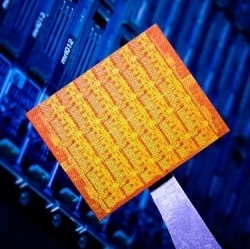
In a key step toward creating a working quantum computer, Princeton University researchers have developed a method that may allow for quick, reliable transfer of quantum information throughout a computing device.
The finding, by a team led by Princeton physicist Jason Petta, could eventually allow engineers to build quantum computers consisting of millions of quantum bits, or qubits. So far, quantum researchers have only been able to manipulate small numbers of qubits.
To make the transfer, Petta’s team used a stream of microwave photons to analyze a pair of electrons trapped in a tiny cage called a quantum dot. The “spin state” of the electrons — information about how they are spinning — serves as the qubit, a basic unit of information. The microwave stream allows the scientists to read that information.
“We create a cavity with mirrors on both ends … that reflect microwave radiation,” Petta said. “We send microwaves in one end, and we look at the microwaves as they come out the other end. The microwaves are affected by the spin states of the electrons in the cavity, and we can read that change.”
In an ordinary sense, the distances involved are very small; the entire apparatus operates over a little more than a centimeter. But on the subatomic scale, they are vast. It is like coordinating the motion of a top spinning on the moon with another on the surface of the earth.
“It’s the most amazing thing,” said Jake Taylor, a physicist at the National Institute of Standards and Technology and the Joint Quantum Institute at the University of Maryland, who worked on the project with the Princeton team. “You have a single electron almost completely changing the properties of an inch-long electrical system.”
For years, teams of scientists have pursued the idea of using quantum mechanics to build a new machine that would revolutionize computing. The goal is not to build a faster or more powerful computer, but to build one that approaches problems in a completely different fashion.
One challenge facing scientists is that the spins of electrons, or any other quantum particles, are incredibly delicate. Any outside influences, whether a wisp of magnetism or glimpse of light, destabilizes the electrons’ spins and introduces errors.
